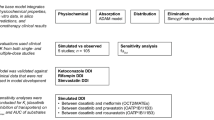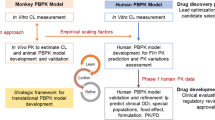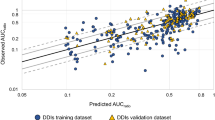Abstract
Objective
An in vitro relative activity factor (RAF) technique combined with mechanistic static modeling was examined to predict drug-drug interaction (DDI) magnitude and analyze contributions of different clearance pathways in complex DDIs involving transporter substrates. Atorvastatin and rifampicin were used as a model substrate and inhibitor pair.
Methods
In vitro studies were conducted with transfected HEK293 cells, hepatocytes and human liver microsomes. Prediction success was defined as predictions being within twofold of observations.
Results
The RAF method successfully translated atorvastatin uptake from transfected cells to hepatocytes, demonstrating its ability to quantify transporter contributions to uptake. Successful translation of atorvastatin’s in vivo intrinsic hepatic clearance (CLint,h,in vivo) from hepatocytes to liver was only achieved through consideration of albumin facilitated uptake or through application of empirical scaling factors to transporter-mediated clearances. Transporter protein expression differences between hepatocytes and liver did not affect CLint,h,in vivo predictions. By integrating cis and trans inhibition of OATP1B1/OATP1B3, atorvastatin-rifampicin (single dose) DDI magnitude could be accurately predicted (predictions within 0.77–1.0 fold of observations). Simulations indicated that concurrent inhibition of both OATP1B1 and OATP1B3 caused approximately 80% of atorvastatin exposure increases (AUCR) in the presence of rifampicin. Inhibiting biliary elimination, hepatic metabolism, OATP2B1, NTCP, and basolateral efflux are predicted to have minimal to no effect on AUCR.
Conclusions
This study demonstrates the effective application of a RAF-based translation method combined with mechanistic static modeling for transporter substrate DDI predictions and subsequent mechanistic interpretation.




Similar content being viewed by others
Data Availability
The datasets generated and analyzed during the current study are available from the corresponding author on reasonable request.
References
FDA. Guidance for industry: In vitro drug interaction studies - cytochrome P45 enzyme- and transporter-mediated drug interactions (January 2020, clinical pharmacology). Website. [Internet]. 2020. Available from: https://www.fda.gov/regulatory-information/search-fda-guidance-documents/in-vitro-drug-interaction-studies-cytochrome-p450-enzyme-and-transporter-mediated-drug-interactions. Accessed 1 June 2023.
ICH-M12. ICH Guideline M12 on drug interaction studies - Step 2b [Internet]. 2022. Available from: https://www.ema.europa.eu/en/documents/scientific-guideline/draft-ich-guideline-m12-drug-interaction-studies-step-2b_en.pdf. Accessed 1 June 2023.
EMA. European Medicines Agency (EMA), Committee for Human Medicinal Products (CHMP): guideline on the investigation of drug interactions [Internet]. 2012. Available from: https://www.ema.europa.eu/en/documents/scientific-guideline/guideline-investigation-drug-interactions-revision-1_en.pdf. Accessed 1 June 2023.
PMDA. Ministry of Health, Labour and Welfare: Guideline on drug interaction for drug development and appropriate provision of information [Internet]. 2019. Available from: https://www.pmda.go.jp/files/000228122.pdf. Accessed 1 June 2023.
Sane R, Cheung KWK, Kovács P, Farasyn T, Li R, Bui A, et al. Calibrating the in vitro-in vivo correlation for OATP mediated drug-drug interactions with rosuvastatin using static and PBPK models. Drug Metab Dispos. 2020;48:1264–70.
Kimoto E, Costales C, West MA, Bi Y, Vourvahis M, Rodrigues AD, et al. Biomarker-informed model-based risk assessment of organic anion transporting polypeptide 1B mediated drug-drug interactions. Clin Pharmacol Ther. 2022;111:404–15.
Li J, Volpe DA, Wang Y, Zhang W, Bode C, Owen A, et al. Use of transporter knockdown Caco-2 cells to investigate the in vitro efflux of statin drugs. Drug Metab Dispos. 2011;39:1196–202.
Lennernäs H. Clinical pharmacokinetics of atorvastatin. Clin Pharmacokinet. 2003;42:1141–60.
Zhang Y, Panfen E, Fancher M, Sinz M, Marathe P, Shen H. Dissecting the contribution of OATP1B1 to hepatic uptake of statins using the OATP1B1 selective inhibitor estropipate. Mol Pharmaceut. 2019;16:2342–53.
Kajosaari LI, Laitila J, Neuvonen PJ, Backman JT. Metabolism of repaglinide by CYP2C8 and CYP3A4 in vitro: effect of fibrates and rifampicin. Basic Clin Pharmacol. 2005;97:249–56.
Pedersen JM, Khan EK, Bergström CAS, Palm J, Hoogstraate J, Artursson P. Substrate and method dependent inhibition of three ABC-transporters (MDR1, BCRP, and MRP2). Eur J Pharm Sci. 2017;103:70–6.
Camenisch G, Umehara K. Predicting human hepatic clearance from in vitro drug metabolism and transport data: a scientific and pharmaceutical perspective for assessing drug–drug interactions. Biopharm Drug Dispos. 2012;33:179–94.
Chu X, Chan GH, Houle R, Lin M, Yabut J, Fandozzi C. In vitro assessment of transporter mediated perpetrator DDIs for several hepatitis C virus direct-acting antiviral drugs and prediction of DDIs with statins using static models. AAPS J. 2022;24:45.
Varma MV, Bi Y, Kimoto E, Lin J. Quantitative prediction of transporter- and enzyme-mediated clinical drug-drug interactions of organic anion-transporting polypeptide 1B1 substrates using a mechanistic net-effect model. J Pharmacol Exp Ther. 2014;351:214–23.
Vildhede A, Karlgren M, Svedberg EK, Wisniewski JR, Lai Y, Norén A, et al. Hepatic uptake of atorvastatin: influence of variability in transporter expression on uptake clearance and drug-drug interactions. Drug Metab Dispos. 2014;42:1210–8.
Izumi S, Nozaki Y, Komori T, Maeda K, Takenaka O, Kusano K, et al. Substrate-dependent inhibition of organic anion transporting polypeptide 1B1: comparative analysis with prototypical probe substrates estradiol-17β-glucuronide, Estrone-3-sulfate, and sulfobromophthalein. Drug Metab Dispos. 2013;41:1859–66.
Taub ME, Mease K, Sane RS, Watson CA, Chen L, Ellens H, et al. Digoxin is not a substrate for organic anion-transporting polypeptide transporters OATP1A2, OATP1B1, OATP1B3, and OATP2B1 but is a substrate for a sodium-dependent transporter expressed in HEK293 cells. Drug Metab Dispos. 2011;39:2093–102.
Izumi S, Nozaki Y, Lee W, Sugiyama Y. Experimental and modeling evidence supporting the trans-inhibition mechanism for preincubation time-dependent, long-lasting inhibition of organic anion transporting polypeptide (OATP) 1B1 by cyclosporine A. Drug Metab Dispos. 2022;50:541–51.
Mitra P, Weinheimer S, Michalewicz M, Taub ME. Prediction and quantification of hepatic transporter-mediated uptake of pitavastatin utilizing a combination of the Relative Activity Factor approach and mechanistic modeling. Drug Metab Dispos. 2018;46:953–63.
Bi Y, Ryu S, Tess DA, Rodrigues AD, Varma MVS. Effect of human plasma on hepatic uptake of organic anion-transporting polypeptide 1B substrates: studies using transfected cells and primary human hepatocytes. Drug Metab Dispos. 2021;49:72–83.
Ito K, Sjöstedt N, Brouwer KLR. Mechanistic modeling of the hepatic disposition of estradiol-17β-glucuronide in Sandwich-cultured human hepatocytes. Drug Metab Dispos. 2020;48:116–22.
Pfeifer ND, Yang K, Brouwer KLR. Hepatic basolateral efflux contributes significantly to rosuvastatin disposition I: characterization of basolateral versus biliary clearance using a novel protocol in Sandwich-cultured hepatocytes. J Pharmacol Exp Ther. 2013;347:727–36.
Ishida K, Ullah M, Toth B, Juhasz V, Unadkat JD. Successful prediction of in vivo hepatobiliary clearances and hepatic concentrations of rosuvastatin using sandwich-cultured rat hepatocytes, transporter-expressing cell lines, and quantitative proteomics. Drug Metab Dispos. 2018;46:66-74.
Mease K, Sane R, Podila L, Taub ME. Differential selectivity of efflux transporter inhibitors in Caco-2 and MDCK–MDR1 monolayers: a strategy to assess the interaction of a new chemical entity with P-gp, BCRP, and MRP2. J Pharm Sci. 2012;101:1888–97.
Abe K, Bridges AS, Brouwer KLR. Use of Sandwich-cultured human hepatocytes to predict biliary clearance of angiotensin II receptor blockers and HMG-CoA reductase inhibitors. Drug Metab Dispos. 2009;37:447–52.
Kilford PJ, Stringer R, Sohal B, Houston JB, Galetin A. Prediction of drug clearance by glucuronidation from in vitro data: use of combined cytochrome P450 and UDP-glucuronosyltransferase cofactors in alamethicin-activated human liver microsomes. Drug Metab Dispos. 2009;37:82–9.
Obach RS. Prediction of human clearance of twenty-nine drugs from hepatic microsomal intrinsic clearance data: an examination of in vitro half-life approach and nonspecific binding to microsomes. Drug Metab Dispos: Biol fate Chem. 1999;27:1350–9.
Kamiie J, Ohtsuki S, Iwase R, Ohmine K, Katsukura Y, Yanai K, et al. Quantitative atlas of membrane transporter proteins: development and application of a highly sensitive simultaneous LC/MS/MS method combined with novel in-silico peptide selection criteria. Pharmaceut Res. 2008;25:1469–83.
Kamiie J, Ohtsuki S, Terasaki T. Method of quantifying membrane protein by using mass spectrometer. U.S. patent 7,901,942 B2, 8 Mar 2011; Japanese patent 4,670,060, 28 Jan 2011. 2011.
Sakamoto A, Matsumaru T, Ishiguro N, Schaefer O, Ohtsuki S, Inoue T, et al. Reliability and robustness of simultaneous absolute quantification of drug transporters, cytochrome P450 enzymes, and udp-glucuronosyltransferases in human liver tissue by multiplexed MRM/SELECTED reaction monitoring mode tandem mass spectrometry with Nano-liquid chromatography. J Pharm Sci. 2011;100:4037–43.
Schaefer M, Morinaga G, Matsui A, Schänzle G, Bischoff D, Süssmuth R. Quantitative expression of hepatobiliary transporters and functional uptake of substrates in hepatic two-dimensional Sandwich cultures: a comparative evaluation of upcyte and primary human hepatocytes. Drug Metab Dispos. 2018;46:166–77.
Sohlenius-Sternbeck A-K. Determination of the hepatocellularity number for human, dog, rabbit, rat and mouse livers from protein concentration measurements. Toxicol In Vitro. 2006;20:1582–6.
Jamei M, Bajot F, Neuhoff S, Barter Z, Yang J, Rostami-Hodjegan A, et al. A mechanistic framework for in vitro–in vivo extrapolation of liver membrane transporters: prediction of drug-drug interaction between rosuvastatin and cyclosporine. Clin Pharmacokinet. 2014;53:73–87.
Davies B, Morris T. Physiological parameters in laboratory animals and humans. Pharmaceut Res. 1993;10:1093–5.
Lau YY, Huang Y, Frassetto L, Benet LZ. Effect of OATP1B transporter inhibition on the pharmacokinetics of atorvastatin in healthy volunteers. Clin Pharmacol Ther. 2007;81:194–204.
Litjens CHC, Aarnoutse RE, Kolmer E-B, Svensson EM, Colbers A, Burger DM, et al. Protein binding of rifampicin is not saturated when using high-dose rifampicin. J Antimicrob Chemoth. 2019;74:986–90.
Shou M, Hayashi M, Pan Y, Xu Y, Morrissey K, Xu L, et al. Modeling, prediction, and in vitro in vivo correlation of CYP3A4 induction. Drug Metab Dispos. 2008;36:2355–70.
Boman G, Ringberger VA. Binding of rifampicin by human plasma proteins. Eur J Clin Pharmacol. 1974;7:369–73.
Woo J, Cheung W, Chan R, Chan HS, Cheng A, Chan K. In vitro protein binding characteristics of isoniazid, rifampicin, and pyrazinamide to whole plasma, albumin, and α-1-acid glycoprotein. Clin Biochem. 1996;29:175–7.
Sun Y, Chothe PP, Sager J, Tsao H, Moore A, Laitinen L, et al. Quantitative prediction of CYP3A4 induction: impact of measured, free and intracellular perpetrator concentrations from human hepatocyte induction studies on drug-drug interaction predictions. Drug Metab Dispos. 2017;45:692–705.
Bi Y, Costales C, Mathialagan S, West M, Eatemadpour S, Lazzaro S, et al. Quantitative contribution of six major transporters to the hepatic uptake of drugs: “SLC-phenoty**” using primary human hepatocytes. J Pharmacol Exp Ther. 2019;370:72–83.
Deng F, Tuomi S-K, Neuvonen M, Hirvensalo P, Kulju S, Wenzel C, et al. Comparative hepatic and intestinal efflux transport of statins. Drug Metab Dispos. 2021;49:750–9.
Duan P, Zhao P, Zhang L. Physiologically based pharmacokinetic (PBPK) modeling of pitavastatin and atorvastatin to predict drug-drug interactions (DDIs). Eur J Drug Metab Ph. 2017;42:689–705.
Chothe PP, Wu S-P, Ye Z, Hariparsad N. Assessment of transporter-mediated and passive hepatic uptake clearance using rifamycin-SV as a pan-inhibitor of active uptake. Mol Pharmaceut. 2018;15:4677–88.
Izumi S, Nozaki Y, Komori T, Takenaka O, Maeda K, Kusuhara H, et al. Comparison of the predictability of human hepatic clearance for organic anion transporting polypeptide substrate drugs between different in vitro–in vivo extrapolation approaches. J Pharm Sci. 2017;106:2678–87.
Filppula AM, Hirvensalo P, Parviainen H, Ivaska VE, Lönnberg KI, Deng F, et al. Comparative hepatic and intestinal metabolism and pharmacodynamics of statins. Drug Metab Dispos. 2021;49:658–67.
Bowman CM, Benet LZ. In vitro–in vivo inaccuracy: the CYP3A4 anomaly. Drug Metab Dispos. 2019;47:1368–71.
Sandoval P, Chuang B-C, Fallon JK, Smith PC, Chowdhury SK, Griffin RJ, et al. Sinusoidal organic anion-transporting polypeptide 1B1/1B3 and bile canalicular multidrug resistance-associated protein 2 play an essential role in the hepatobiliary disposition of a synthetic cyclic dinucleotide (STING agonist). AAPS J. 2022;24:99.
Li CY, Gupta A, Gáborik Z, Kis E, Prasad B. OATP-mediated hepatic uptake of glucuronide metabolites of androgens. Mol Pharmacol. 2020;98:234–42.
Vildhede A, Mateus A, Khan EK, Lai Y, Karlgren M, Artursson P, et al. Mechanistic modeling of pitavastatin disposition in Sandwich-cultured human hepatocytes: a proteomics-informed bottom-up approach. Drug Metab Dispos. 2016;44:505–16.
Ohtsuki S, Schaefer O, Kawakami H, Inoue T, Liehner S, Saito A, et al. Simultaneous absolute protein quantification of transporters, cytochromes P450, and UDP-glucuronosyltransferases as a novel approach for the characterization of individual human liver: comparison with mRNA levels and activities. Drug Metab Dispos. 2012;40:83–92.
Kumar V, Yin M, Ishida K, Salphati L, Hop CECA, Rowbottom C, et al. Prediction of transporter-mediated rosuvastatin hepatic uptake clearance and drug interaction in humans using proteomics-informed REF approach. Drug Metab Dispos. 2021;49:159–68.
Kumar V, Salphati L, Hop CECA, **ao G, Lai Y, Mathias A, et al. A comparison of total and plasma membrane abundance of transporters in suspended, plated, sandwich-cultured human hepatocytes vs. human liver tissue using quantitative targeted proteomics and cell-surface biotinylation. Drug Metab Dispos. 2019;47:350–7.
Kim S-J, Lee K-R, Miyauchi S, Sugiyama Y. Extrapolation of in vivo hepatic clearance from in vitro uptake clearance by suspended human hepatocytes (ivive) for anionic drugs with high binding to human albumin: improvement of IVIVE by Considering the “Albumin-Mediated” Hepatic Uptake Mechanism Based on the facilitated-dissociation Model. Drug Metab Dispos. 2019;47:94–103.
Francis LJ, Houston B, Hallifax D. Impact of plasma protein binding in drug clearance prediction: a database analysis of published studies and implications for in vitro in vivo extrapolation. Drug Metab Dispos. 2021;49:188–201.
Yin M, Ishida K, Liang X, Lai Y, Unadkat JD. Interpretation of protein-mediated uptake of statins by hepatocytes is confounded by the residual statin-protein complex. Drug Metab Dispos. 2023;51:1381–90.
Yin M, Storelli F, Unadkat JD. Is the protein-mediated uptake of drugs by OATPs a real phenomenon or an artifact? Drug Metab Dispos. 2022;50:1132–41.
Morse BL, MacGuire JG, Marino AM, Zhao Y, Fox M, Zhang Y, et al. Physiologically based pharmacokinetic modeling of transporter-mediated hepatic clearance and liver partitioning of OATP and OCT substrates in cynomolgus monkeys. AAPS J. 2017;19:1878–89.
Costales C, Lin J, Kimoto E, Yamazaki S, Gosset JR, Rodrigues AD, et al. Quantitative prediction of breast cancer resistant protein mediated drug-drug interactions using physiologically-based pharmacokinetic modeling. Cpt Pharmacometrics Syst Pharmacol. 2021;10:1018–31.
Morse BL, Alberts JJ, Posada MM, Rehmel J, Kolur A, Tham LS, et al. Physiologically-based pharmacokinetic modeling of atorvastatin incorporating delayed gastric emptying and acid-to-lactone conversion. Cpt Pharmacometrics Syst Pharmacol. 2019;8:664–75.
Li R. Estimating in vivo fractional contribution of OATP1B1 to human hepatic active uptake by mechanistically modeling pharmacogenetic data. AAPS J. 2019;21:69.
Yoshikado T, Lee W, Toshimoto K, Morita K, Kiriake A, Chu X, et al. Evaluation of hepatic uptake of OATP1B substrates by short term-cultured plated human hepatocytes: comparison with isolated suspended hepatocytes. J Pharm Sci. 2021;110:376–87.
Bi Y, Scialis RJ, Lazzaro S, Mathialagan S, Kimoto E, Keefer J, et al. Reliable rate measurements for active and passive hepatic uptake using plated human hepatocytes. AAPS J. 2017;19:787–96.
Kimoto E, Bi Y-A, Kosa RE, Tremaine LM, Varma MVS. Hepatobiliary clearance prediction: species scaling from monkey, dog, and rat, and in vitro–in vivo extrapolation of Sandwich-cultured human hepatocytes using 17 drugs. J Pharm Sci. 2017;106:2795–804.
Hoffmaster KA, Turncliff RZ, LeCluyse EL, Kim RB, Meier PJ, Brouwer KLR. P-glycoprotein expression, localization, and function in Sandwich-cultured primary rat and human hepatocytes: relevance to the hepatobiliary disposition of a model opioid peptide. Pharm Res. 2004;21:1294–302.
Chothe PP, Pemberton R, Hariparsad N. Function and expression of bile salt export pump in suspension human hepatocytes. Drug Metab Dispos. 2021;49:314–21.
Tátrai P, Schweigler P, Poller B, Domange N, de Wilde R, Hanna I, et al. A systematic in vitro investigation of the inhibitor preincubation effect on multiple classes of clinically relevant transporters. Drug Metab Dispos. 2019;47:768–78.
Pahwa S, Alam K, Crowe A, Farasyn T, Neuhoff S, Hatley O, et al. Pretreatment with rifampicin and tyrosine kinase inhibitor dasatinib potentiates the inhibitory effects toward OATP1B1- and OATP1B3-mediated transport. J Pharm Sci. 2017;106:2123–35.
Tirona RG, Leake BF, Wolkoff AW, Kim RB. Human organic anion transporting polypeptide-C (SLC21A6) is a major determinant of rifampin-mediated pregnane X receptor activation. J Pharmacol Exp Ther. 2003;304:223–8.
Higgins JW, Bao JQ, Ke AB, Manro JR, Fallon JK, Smith PC, et al. Utility of Oatp1a/1b-knockout and OATP1B1/3-humanized mice in the study of OATP-mediated pharmacokinetics and tissue distribution: case studies with pravastatin, atorvastatin, simvastatin, and carboxydichlorofluorescein. Drug Metab Dispos. 2014;42:182–92.
Maeda K. Organic anion transporting polypeptide (OATP)1B1 and OATP1B3 as important regulators of the pharmacokinetics of substrate drugs. Biological Pharm Bull. 2015;38:155–68.
Woo HI, Kim SR, Huh W, Ko J-W, Lee S-Y. Association of genetic variations with pharmacokinetics and lipid-lowering response to atorvastatin in healthy korean subjects. Drug Des Dev Ther. 2017;11:1135–46.
Keskitalo J, Kurkinen K, Neuvonen P, Niemi M. ABCB1 haplotypes differentially affect the pharmacokinetics of the acid and lactone forms of simvastatin and atorvastatin. Clin Pharmacol Ther. 2008;84:457–61.
Lee YJ, Lee MG, Lim LA, Jang SB, Chung JY. Effects of SLCO1B1 and ABCB1 genotypes on the pharmacokinetics of atorvastatin and 2-hydroxyatorvastatin in healthy Korean subjects. Int J Clin Pharmacol Ther. 2010;48:36–45.
Acknowledgements
The authors would like to thank Dr. Timothy Tracy for his contributions to the manuscript review and his constructive suggestions. The authors also thank Dr. Ting Wang for imparting training in conducting HLM experiments.
Funding
The work presented here was funded by Boehringer-Ingelheim Pharmaceuticals, Inc.
Author information
Authors and Affiliations
Contributions
Pallabi Mitra: Research design, data analysis, wrote manuscript, bioanalysis.
Rumanah Kasliwala: Conducted experiments, data analysis, contributed to writing manuscript.
Laeticia Iboki: Conducted experiments, data analysis.
Shilpa Madari: Conducted experiments, data analysis.
Zachary Williams: Conducted experiments, data analysis.
Ryo Takahashi (proteomics): Research design, conducted experiments, data analysis, contributed to writing manuscript.
Mitchell Taub: Research design, contributed to writing manuscript.
Corresponding author
Ethics declarations
Conflict of Interest
All authors are full-time employees of Boehringer Ingelheim Pharmaceuticals, Inc.
Additional information
Publisher's Note
Springer Nature remains neutral with regard to jurisdictional claims in published maps and institutional affiliations.
Supplementary Information
Below is the link to the electronic supplementary material.
Rights and permissions
Springer Nature or its licensor (e.g. a society or other partner) holds exclusive rights to this article under a publishing agreement with the author(s) or other rightsholder(s); author self-archiving of the accepted manuscript version of this article is solely governed by the terms of such publishing agreement and applicable law.
About this article
Cite this article
Mitra, P., Kasliwala, R., Iboki, L. et al. Mechanistic Static Model based Prediction of Transporter Substrate Drug-Drug Interactions Utilizing Atorvastatin and Rifampicin. Pharm Res 40, 3025–3042 (2023). https://doi.org/10.1007/s11095-023-03613-x
Received:
Accepted:
Published:
Issue Date:
DOI: https://doi.org/10.1007/s11095-023-03613-x




